We are all more or less au fait with the Vuelta al País Vasco in terms of format by now. No long stages, but no respites at all. There will be a stage which is pseudo-flat using gradual climbs that ends in a sort of sprint but with no strong sprinting field; there will be an uphill-type finish of some description; there will be a couple of tricky up-and-down stages with some punchy short-to-mid-length climbs, and there's a TT to finish, which is usually very technical and hilly.
And there's a mountaintop finish at the Santuário de Arrate, overlooking Eibar.

Arrate is an ideal type of climb for País Vasco; the gaps it produces are not massive because the steep section only lasts just over 3km. The gradients are steep enough to cause trouble but not enough to be a carnival stage that means riders are too afraid to make moves in earlier stages. But it wasn't always thus. In fact, Arrate has only been a regular part of the Itzulia since 2009. Before that it was, instead, the important final climb of the Euskal Bizikleta, a sadly departed short stage race organized around the Eibar area (a counterpart to the Emakumeen Bira, literally "women's race", a Durango-based equivalent to the race that still survives on the women's calendar). And before that, from 1941 until 1990 it had its own race, the Subida a Arrate, one of those traditional Spanish one-day races finishing on a mountain climb (although in the late 80s it became a short stage race, a harbinger of its future). The Bizikleta merged with the Itzulia in 2009, but that meant that the existing contract that the city of Eibar had with regards to the use of the Arrate finish could be honoured by the Itzulia, as opposed to if the Bizikleta had simply died off, allowing the legendary summit to maintain its lustre - the Subida a Arrate and Euskal Bizikleta both had quite illustrious winner's lists.
The contract that was valid was for ten years, and I believe it was in 2007 though I may be forgetting the details. Either way, we're now headed towards the end. It is more than likely that the city of Eibar, which has ties to organized cycle racing dating back to the 1930s, will renew its contract with the organizers of the Itzulia, and enable the Arrate summit/descent finish to remain a part of the race's history.
But what if they didn't? Who would step in and provide the Basques with a summit par excellence to suit the race? And who could viably, realistically do so, so there would need to be some space there and a town or municipality who could pay for it?
1: Puerto de Urkiola

The first, and most obvious, option as a replacement summit would be the Puerto (and Santuário) de Urkiola. Arguably the only Basque climb more storied and historic than Arrate, it has been known as the great cathedral of Basque cycling, and had its own one-day climbing race, which ran until 2009, and began way back in 1931 (although it has run off-and-on for periods in between), and was also one of the most legendary climbs of the Vuelta a España in the late 60s and early 70s when the race finished in País Vasco. To the pass is 5,7km @ 9,1%, to the Santuário is 6,1km @ 9,2%. A kilometre out there is a glorious steep right-hander called Txakurzulo, at which a beautiful viewpoint is located, and a long straight at 14% follows; it is here where the fans tend to cluster. Perhaps slightly tougher than Arrate, but certainly offering the similar kind of smallish time gaps. Because of the one-day nature of the race time gaps were often bigger in the Subida a Urkiola than they might have been in a stage race where people have something to protect even if they're not on 100% form, but races like the 2004 and 2009 editions, where most of the pack got to Mañaria together, give a decent indication of time gaps (spread of 47" and 55" for the top 10 respectively), as well as climbs like Peña Cabarga in the Vuelta, which is a similar but slightly more irregular climb.
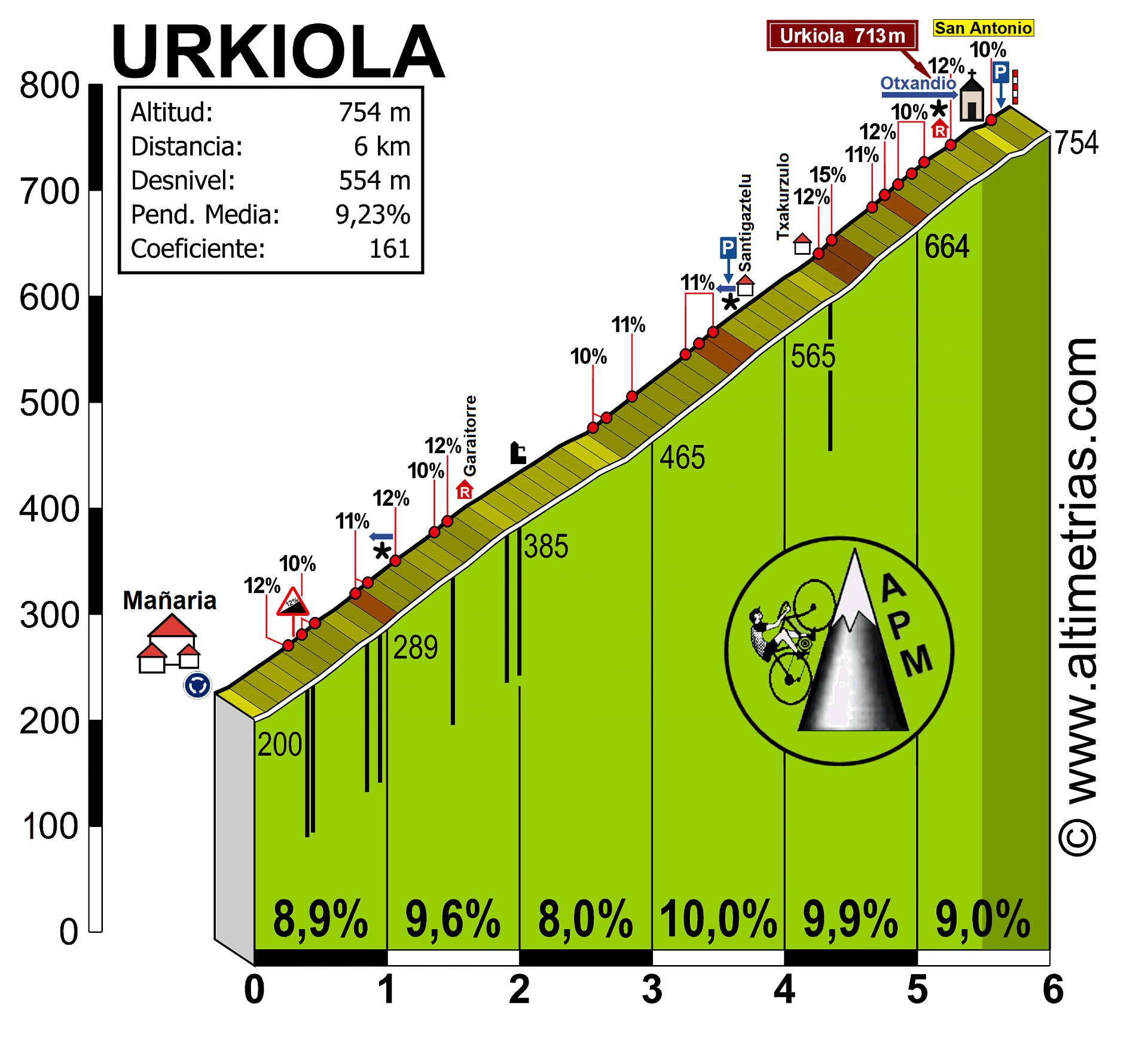
2. Santuário de Arantzazu

Prior to the merger between the Euskal Bizikleta and the Vuelta al País Vasco, the rebuilt Sanctuary to Our Lady of Arantzazu and San Ignacio de Loyola hosted a finish of a tricky semitappe in 2005, paid for by the municipality of Oñati, which saw the final stage and ITT in 2012. Although the gaps back then were sizable, as a major stage I would not expect major gaps here, however. The climb's overall statistics are 7,8km @ 6,0% however almost all the steep stuff is concentrated into the first 3km; after that it is comparatively gradual. It will make for an interesting sprint of a small group in modern cycling, but would need to be paired with another stage to open gaps before it in order to get the most out of it, I think. Valverde would like it, though.
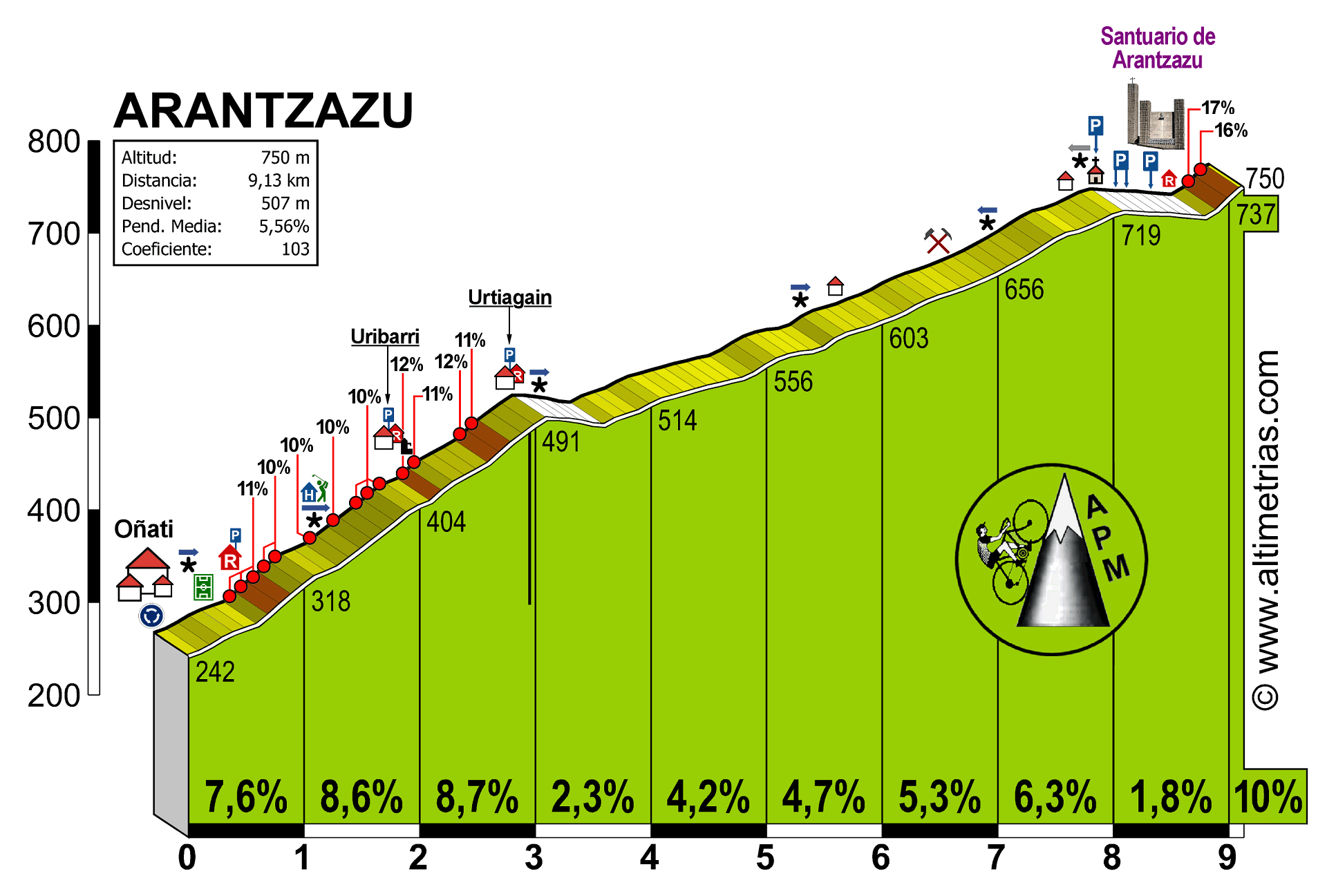
3. Alto de Bianditz

On the border between Gipuzkoa and Navarra, this is a longer but less typically Basque climb. The actual summit would, Arrate-style, come about 1,5km before the actual finish, which would need to be at the Artikutza natural park entrance above. After the first kilometre, the whole climb is between 5 and 7%, which is why we need a somewhat longer climb to create the gaps. The overall stats on this one are 11,8km @ 5,6% but it does come with one real benefit - it can be paired directly after the great Alto de Erlaitz climb, which is officially 9,2km @ 5,2% but has 3km @ 11% in the middle of it - it was the most important climb of the 2007 edition, when Juan José Cobo used it to destroy the field.
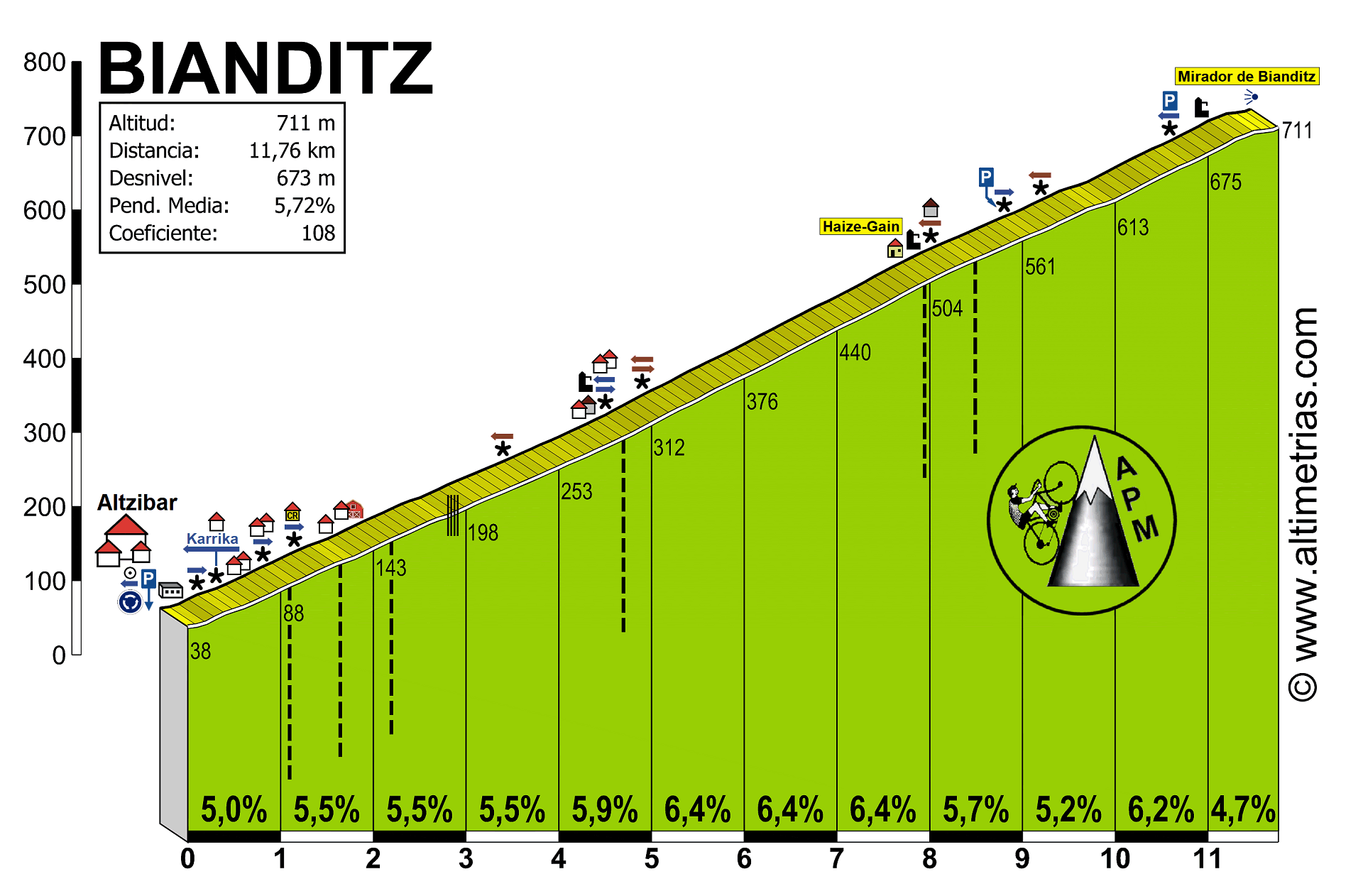
4. Cuevas de la Pozalágua
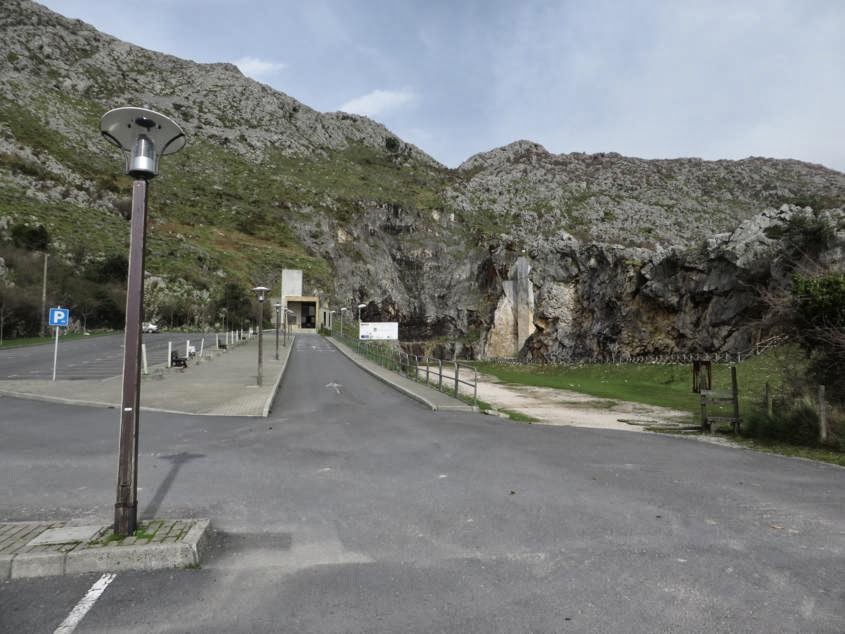
Over on the far west side of the region, this climb in the Valle de Karrantza was last seen as a stage finish in the 2007 Itzulia, when Triki Beltrán won. Gaps were roughly ideal for a País Vasco MTF - top 20 in 1'06", with a sizable group around the 26" mark. The actual climb is called Peña Ranero, but this is in much the same way as the actual summit when climbing Arrate is called the Alto de Usartza; the entrance to Cuevas de la Pozalágua is just 400m after the summit; the climb is, overall, 5,2km @ 7,1% but with the last 1,5km of ascent at nearly 10% and with ramps of up to 18% near the end.

5. Puerto de Sollube
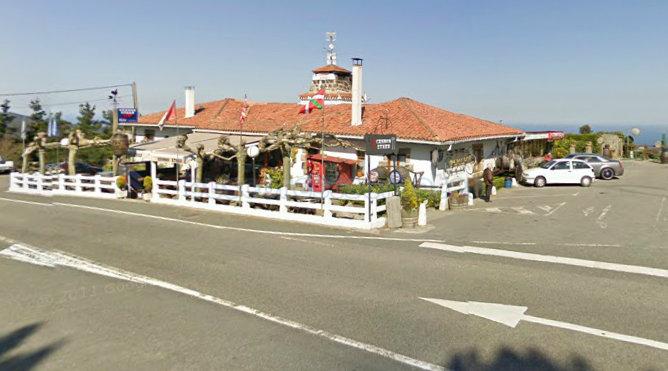
You can't really see it on that photo, but atop the sign in front of the restaurant there is a bike; this climb with its scenic views of the Bay of Biscay and the Urdaibai Estuary has been a famous part of Basque cycling over its history too, not to mention history in general, thanks to the Spanish Civil War, when its strategic position led to a battle for possession of the mountain. The pass is quite low - some 300m below the peak of the mountain. You can climb up to the Antennas de Sollube, but realistically the Mirador del Restaurante at the pass would be the most likely finish. There are a LOT of sides to this pass, so a loop with Bermeo hosting the finish and multiple ascents like with El Vivero in today's stage is always possible.
- the classic side from Bermeo is 5,2km @ 7,1% much like Cuevas de la Pozalágua, but not with as many steep ramps:

- from Larrauri, the other major side, it's 3km @ 8% followed by 4km of false flat; not a great climb, but this profile lets us see the ascent from the Puerto to the Antennas, which would be the same for all sides:
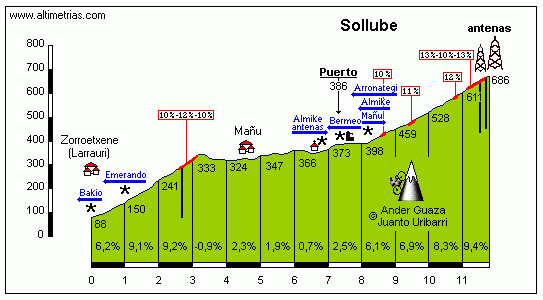
- from Bermeo via Artike is 7,6km @ 5,1% although the first 3km are false flat, the last 4,6km are at 7% including some horrible ramps on narrow, typically inconsistent Basque roads, as opposed to the first two sides, on nice two-way roads:

- from Bakio (the northwest side) is 6,1km @ 6,1% however this is perhaps the most brutal side, with 3km @ 10% in the first half, 2km of which is on hormigón, those nasty cement roads like on Bola del Mundo, Camino de las Acebadillas or San Miguel de Áralar. This is therefore perhaps the least realistic route, but would enable us to descend into Bermeo and then do the Artike side straight after, or loop around San Pelaio and climb it again:

6. La Reineta/La Arboleda/La Lejana

These three connected settlements sit together on a mountaintop overlooking Bilbao and its satellite towns spreading towards the coast - Barakaldo, Santurtzi, Portugalete, Trapagarán and so on. The latter is usually the one that pays up when the Itzulia heads into town, last doing so in 2013. There are a number of ways to get here; La Reineta and La Lejana are on adjacent summits with La Arboleda in between. It also has the benefit of being extremely accessible to fans - there's a funicular that runs up to Larreineta (Basque spelling) meaning access from Bilbao is extremely easy and doesn't require the usual trip on the narrow-gauge Euskotren followed by a tiring walk or cycle up the hill! Again, many routes to the top:
- via Las Calizas like in 2013 is 10,1km @ 4,6% but is divided into a number of separate shorter ramps.
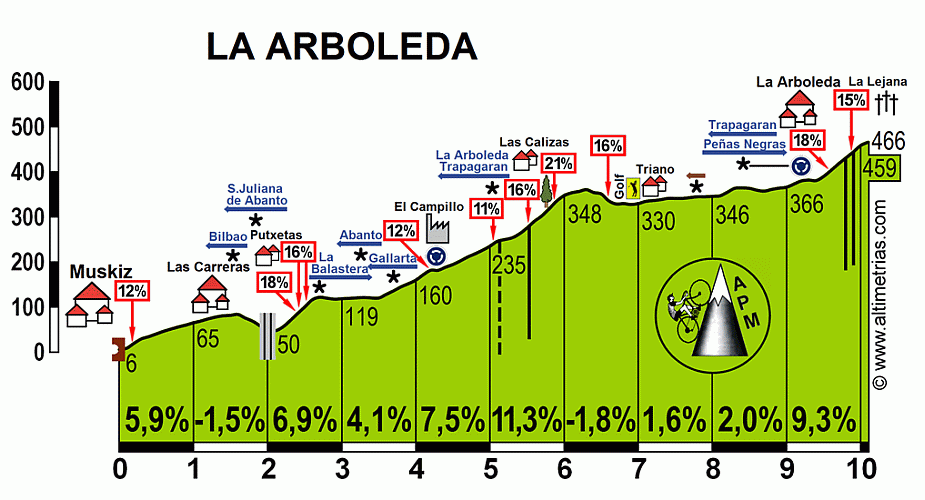
- from Trapagarán is 8,3km @ 5,2% although there's about 6km @ 6% to La Reineta (which could host a finish but as it's fairly consistent I can't see many gaps from this route, whereas the last km to La Lejana is steep) then a descent into La Arboleda.
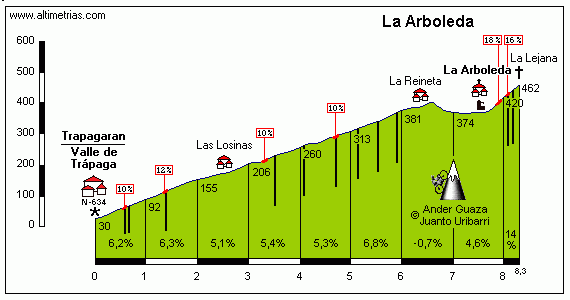
- from Urioste is 9,0km @ 3,8% and, though there are a couple of steeper kilometres, isn't very interesting.

- the most interesting thing about it is it shows us the 3km or so descent needed to do the climb as a finish via Peñas Negras (Alto de la Asturiana). This ascent is 7,6km @ 6,2% but with the first 3km @ 9,0% - this is a lot like the Arantzazu climb with the second half being comparatively easy, although the possibility to do the descent of around 3km and then the steeper final kilometre into La Lejana is tempting.

- finishing in La Reineta, there is the possibility for the same kind of 3km or so descent (the descent is on the right hand side here) to a finish (or again circa 5km with the steep ascent into La Lejana to finish) after a climb to Argalário, or rather to the final part of it (the overall climb is 8,7km @ 6,1% by the classic route, but we would have to take the turning to Barrionuevo after 8,3km). There's also a brutal additional side of this without the false flat, keeping the final 5km @ 8% but replacing the first kilometre with a brutal kilometre of nearly 14% on hormigón, but this is unlikely to be used in racing.
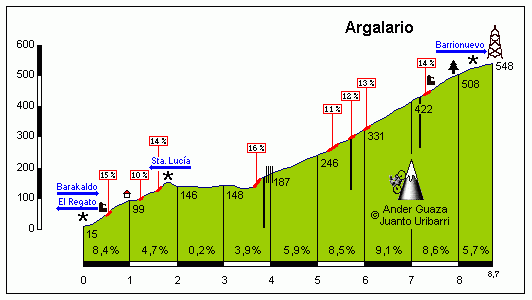
7. Santuário de San Miguel de Áralar
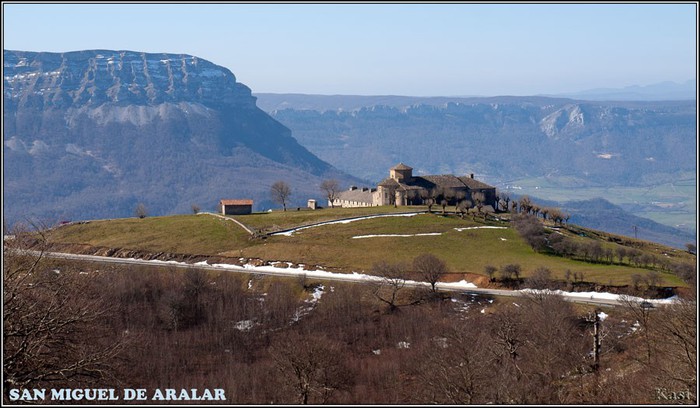
Over in Navarra, this brutal ascent is arguably the toughest Basque climb. Arguable because there are potential tougher climbs in Iparralde; and arguable because it's in Navarre and so the Basque claim to it is controversial. What isn't arguable is that it's brutal. 11,0km @ 8,1%, much of which on hormigón, is pretty serious stuff. The PRC guys gave us an idea of how it can be used here, and while it used to feature occasionally in the Vuelta a Navarra, Unipublic finally got the memo and used this climb in last year's Vuelta a España for the first time, when Fabio Aru triumphed. 13 riders were within a minute, which on the face of it would suggest that this wouldn't be a problematic climb to use, although I am a bit cautious about it for a short stage race because it may block racing in other stages, especially if riders are less conservative than they were in the Vuelta, due to it being the queen stage as opposed to one of a dozen mountain stages.
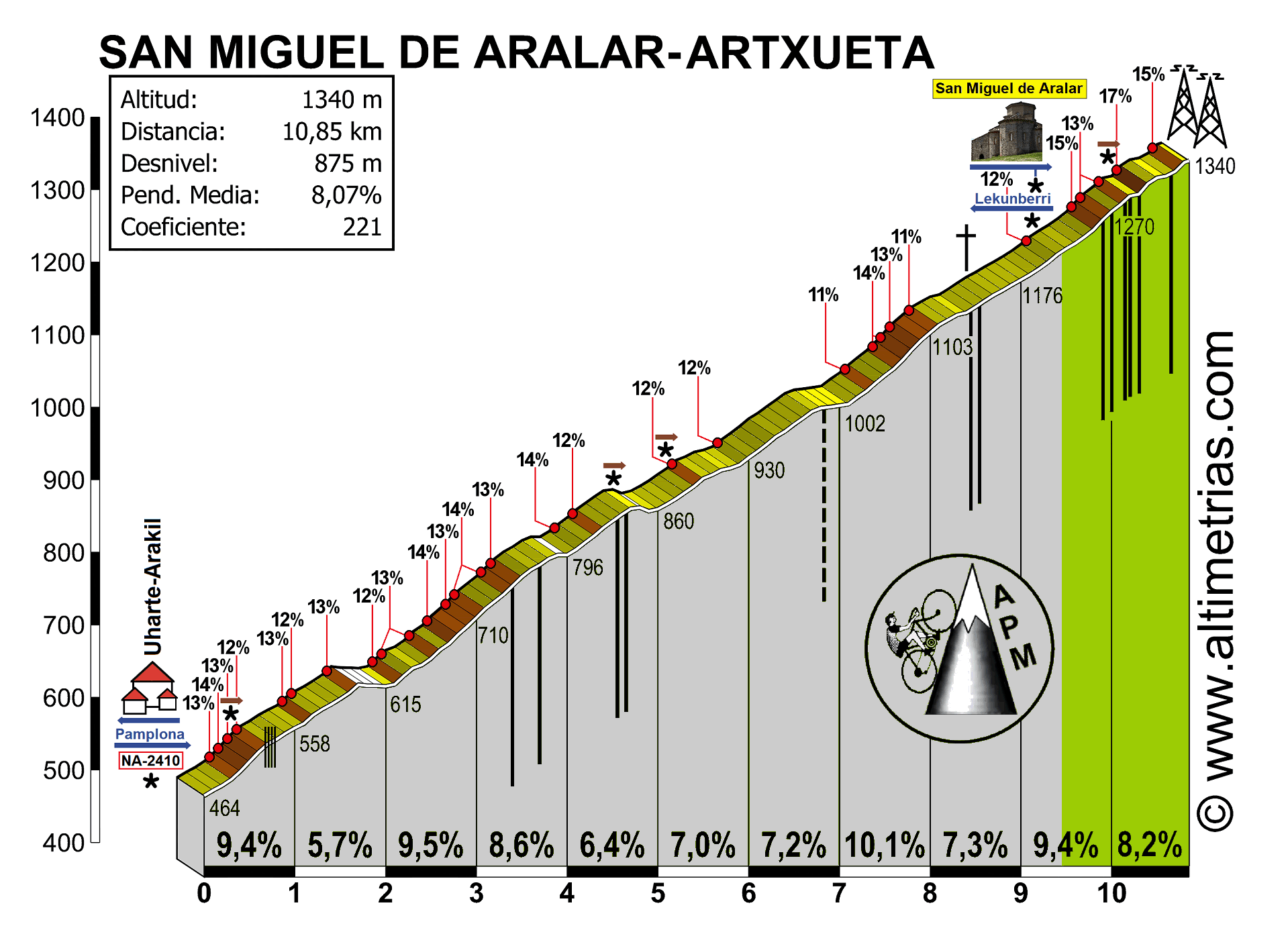
More to follow...
And there's a mountaintop finish at the Santuário de Arrate, overlooking Eibar.

Arrate is an ideal type of climb for País Vasco; the gaps it produces are not massive because the steep section only lasts just over 3km. The gradients are steep enough to cause trouble but not enough to be a carnival stage that means riders are too afraid to make moves in earlier stages. But it wasn't always thus. In fact, Arrate has only been a regular part of the Itzulia since 2009. Before that it was, instead, the important final climb of the Euskal Bizikleta, a sadly departed short stage race organized around the Eibar area (a counterpart to the Emakumeen Bira, literally "women's race", a Durango-based equivalent to the race that still survives on the women's calendar). And before that, from 1941 until 1990 it had its own race, the Subida a Arrate, one of those traditional Spanish one-day races finishing on a mountain climb (although in the late 80s it became a short stage race, a harbinger of its future). The Bizikleta merged with the Itzulia in 2009, but that meant that the existing contract that the city of Eibar had with regards to the use of the Arrate finish could be honoured by the Itzulia, as opposed to if the Bizikleta had simply died off, allowing the legendary summit to maintain its lustre - the Subida a Arrate and Euskal Bizikleta both had quite illustrious winner's lists.
The contract that was valid was for ten years, and I believe it was in 2007 though I may be forgetting the details. Either way, we're now headed towards the end. It is more than likely that the city of Eibar, which has ties to organized cycle racing dating back to the 1930s, will renew its contract with the organizers of the Itzulia, and enable the Arrate summit/descent finish to remain a part of the race's history.
But what if they didn't? Who would step in and provide the Basques with a summit par excellence to suit the race? And who could viably, realistically do so, so there would need to be some space there and a town or municipality who could pay for it?
1: Puerto de Urkiola

The first, and most obvious, option as a replacement summit would be the Puerto (and Santuário) de Urkiola. Arguably the only Basque climb more storied and historic than Arrate, it has been known as the great cathedral of Basque cycling, and had its own one-day climbing race, which ran until 2009, and began way back in 1931 (although it has run off-and-on for periods in between), and was also one of the most legendary climbs of the Vuelta a España in the late 60s and early 70s when the race finished in País Vasco. To the pass is 5,7km @ 9,1%, to the Santuário is 6,1km @ 9,2%. A kilometre out there is a glorious steep right-hander called Txakurzulo, at which a beautiful viewpoint is located, and a long straight at 14% follows; it is here where the fans tend to cluster. Perhaps slightly tougher than Arrate, but certainly offering the similar kind of smallish time gaps. Because of the one-day nature of the race time gaps were often bigger in the Subida a Urkiola than they might have been in a stage race where people have something to protect even if they're not on 100% form, but races like the 2004 and 2009 editions, where most of the pack got to Mañaria together, give a decent indication of time gaps (spread of 47" and 55" for the top 10 respectively), as well as climbs like Peña Cabarga in the Vuelta, which is a similar but slightly more irregular climb.

2. Santuário de Arantzazu

Prior to the merger between the Euskal Bizikleta and the Vuelta al País Vasco, the rebuilt Sanctuary to Our Lady of Arantzazu and San Ignacio de Loyola hosted a finish of a tricky semitappe in 2005, paid for by the municipality of Oñati, which saw the final stage and ITT in 2012. Although the gaps back then were sizable, as a major stage I would not expect major gaps here, however. The climb's overall statistics are 7,8km @ 6,0% however almost all the steep stuff is concentrated into the first 3km; after that it is comparatively gradual. It will make for an interesting sprint of a small group in modern cycling, but would need to be paired with another stage to open gaps before it in order to get the most out of it, I think. Valverde would like it, though.

3. Alto de Bianditz

On the border between Gipuzkoa and Navarra, this is a longer but less typically Basque climb. The actual summit would, Arrate-style, come about 1,5km before the actual finish, which would need to be at the Artikutza natural park entrance above. After the first kilometre, the whole climb is between 5 and 7%, which is why we need a somewhat longer climb to create the gaps. The overall stats on this one are 11,8km @ 5,6% but it does come with one real benefit - it can be paired directly after the great Alto de Erlaitz climb, which is officially 9,2km @ 5,2% but has 3km @ 11% in the middle of it - it was the most important climb of the 2007 edition, when Juan José Cobo used it to destroy the field.

4. Cuevas de la Pozalágua

Over on the far west side of the region, this climb in the Valle de Karrantza was last seen as a stage finish in the 2007 Itzulia, when Triki Beltrán won. Gaps were roughly ideal for a País Vasco MTF - top 20 in 1'06", with a sizable group around the 26" mark. The actual climb is called Peña Ranero, but this is in much the same way as the actual summit when climbing Arrate is called the Alto de Usartza; the entrance to Cuevas de la Pozalágua is just 400m after the summit; the climb is, overall, 5,2km @ 7,1% but with the last 1,5km of ascent at nearly 10% and with ramps of up to 18% near the end.

5. Puerto de Sollube

You can't really see it on that photo, but atop the sign in front of the restaurant there is a bike; this climb with its scenic views of the Bay of Biscay and the Urdaibai Estuary has been a famous part of Basque cycling over its history too, not to mention history in general, thanks to the Spanish Civil War, when its strategic position led to a battle for possession of the mountain. The pass is quite low - some 300m below the peak of the mountain. You can climb up to the Antennas de Sollube, but realistically the Mirador del Restaurante at the pass would be the most likely finish. There are a LOT of sides to this pass, so a loop with Bermeo hosting the finish and multiple ascents like with El Vivero in today's stage is always possible.
- the classic side from Bermeo is 5,2km @ 7,1% much like Cuevas de la Pozalágua, but not with as many steep ramps:

- from Larrauri, the other major side, it's 3km @ 8% followed by 4km of false flat; not a great climb, but this profile lets us see the ascent from the Puerto to the Antennas, which would be the same for all sides:

- from Bermeo via Artike is 7,6km @ 5,1% although the first 3km are false flat, the last 4,6km are at 7% including some horrible ramps on narrow, typically inconsistent Basque roads, as opposed to the first two sides, on nice two-way roads:

- from Bakio (the northwest side) is 6,1km @ 6,1% however this is perhaps the most brutal side, with 3km @ 10% in the first half, 2km of which is on hormigón, those nasty cement roads like on Bola del Mundo, Camino de las Acebadillas or San Miguel de Áralar. This is therefore perhaps the least realistic route, but would enable us to descend into Bermeo and then do the Artike side straight after, or loop around San Pelaio and climb it again:

6. La Reineta/La Arboleda/La Lejana

These three connected settlements sit together on a mountaintop overlooking Bilbao and its satellite towns spreading towards the coast - Barakaldo, Santurtzi, Portugalete, Trapagarán and so on. The latter is usually the one that pays up when the Itzulia heads into town, last doing so in 2013. There are a number of ways to get here; La Reineta and La Lejana are on adjacent summits with La Arboleda in between. It also has the benefit of being extremely accessible to fans - there's a funicular that runs up to Larreineta (Basque spelling) meaning access from Bilbao is extremely easy and doesn't require the usual trip on the narrow-gauge Euskotren followed by a tiring walk or cycle up the hill! Again, many routes to the top:
- via Las Calizas like in 2013 is 10,1km @ 4,6% but is divided into a number of separate shorter ramps.

- from Trapagarán is 8,3km @ 5,2% although there's about 6km @ 6% to La Reineta (which could host a finish but as it's fairly consistent I can't see many gaps from this route, whereas the last km to La Lejana is steep) then a descent into La Arboleda.

- from Urioste is 9,0km @ 3,8% and, though there are a couple of steeper kilometres, isn't very interesting.

- the most interesting thing about it is it shows us the 3km or so descent needed to do the climb as a finish via Peñas Negras (Alto de la Asturiana). This ascent is 7,6km @ 6,2% but with the first 3km @ 9,0% - this is a lot like the Arantzazu climb with the second half being comparatively easy, although the possibility to do the descent of around 3km and then the steeper final kilometre into La Lejana is tempting.

- finishing in La Reineta, there is the possibility for the same kind of 3km or so descent (the descent is on the right hand side here) to a finish (or again circa 5km with the steep ascent into La Lejana to finish) after a climb to Argalário, or rather to the final part of it (the overall climb is 8,7km @ 6,1% by the classic route, but we would have to take the turning to Barrionuevo after 8,3km). There's also a brutal additional side of this without the false flat, keeping the final 5km @ 8% but replacing the first kilometre with a brutal kilometre of nearly 14% on hormigón, but this is unlikely to be used in racing.

7. Santuário de San Miguel de Áralar

Over in Navarra, this brutal ascent is arguably the toughest Basque climb. Arguable because there are potential tougher climbs in Iparralde; and arguable because it's in Navarre and so the Basque claim to it is controversial. What isn't arguable is that it's brutal. 11,0km @ 8,1%, much of which on hormigón, is pretty serious stuff. The PRC guys gave us an idea of how it can be used here, and while it used to feature occasionally in the Vuelta a Navarra, Unipublic finally got the memo and used this climb in last year's Vuelta a España for the first time, when Fabio Aru triumphed. 13 riders were within a minute, which on the face of it would suggest that this wouldn't be a problematic climb to use, although I am a bit cautious about it for a short stage race because it may block racing in other stages, especially if riders are less conservative than they were in the Vuelta, due to it being the queen stage as opposed to one of a dozen mountain stages.

More to follow...










